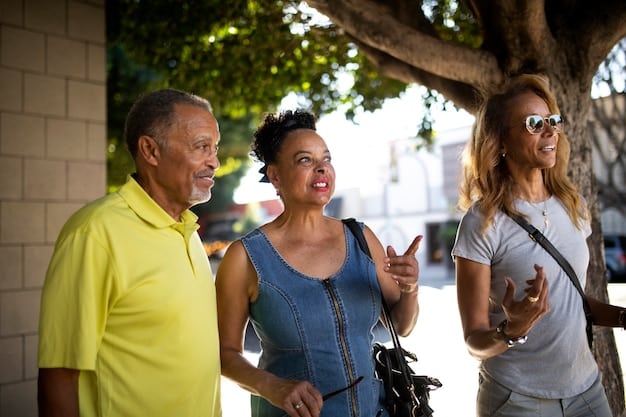Navigating US Social Etiquette: Avoid Common Cultural Missteps

Navigating US social etiquette is crucial for visitors and new residents to foster positive interactions, as understanding local customs helps avoid common cultural missteps and promotes seamless integration into American society.
Embarking on a journey, whether for travel, study, or relocation, involves more than just packing bags; it demands an understanding of the local cultural landscape. When it comes to the United States, mastering navigating US social etiquette: avoid these common cultural missteps can significantly enhance your experience and interactions.
Decoding American Communication Styles
American society places a high value on directness, though often couched in politeness. This balance can be tricky to master for those from cultures where indirect communication or elaborate formalities are the norm. Understanding these nuances is key to effective interaction.
In conversational settings, Americans generally appreciate clear and concise language. They often get straight to the point, valuing efficiency in communication. This doesn’t mean rudeness; rather, it reflects a cultural preference for clarity over ambiguity. For instance, when asking a question, a direct “Where is the nearest subway station?” is more common than a lengthy preamble.
The Role of Directness and Politeness
Directness in the US is often intertwined with a sense of personal responsibility and accountability. People are expected to express their thoughts and needs clearly, rather than relying on others to infer them. However, this directness is usually tempered with politeness markers, such as “please,” “thank you,” “excuse me,” and “I’m sorry,” even in casual interactions.
- Be clear and concise: Avoid lengthy introductions or beating around the bush. State your purpose or question directly.
- Use polite language: Incorporate “please,” “thank you,” and “excuse me” frequently, even when being direct.
- Mind your tone: While direct, avoid aggressive or overly assertive tones. A friendly, open approach is generally preferred.
- Active listening: Show you are engaged by nodding, making eye contact, and offering verbal affirmations.
Beyond directness, the concept of “small talk” is a fundamental aspect of American social interactions. These brief, light conversations often precede or punctuate more substantive discussions. Topics usually steer clear of anything too personal, controversial, or negative, focusing instead on weather, general compliments, or weekend plans. Mastering small talk can help you connect with people and ease into deeper conversations. It’s not about gathering information; it’s about building rapport and showing friendliness. Don’t be surprised if strangers wish you a “good morning” or comment on your outfit – it’s a social gesture, not an invitation for a deep discussion.
Navigating Personal Space and Physical Contact
The concept of personal space varies significantly across cultures, and understanding American norms is crucial to avoid discomfort. In the United States, people generally maintain a larger personal bubble compared to many other parts of the world. Invading this space can be perceived as aggressive or overly familiar, even if unintentionally.
When conversing, individuals typically stand about an arm’s length apart. This distance allows for comfortable conversation without feeling too close or too distant. In crowded public spaces, of course, this ideal distance may not always be possible, but even then, people generally try to avoid unnecessary physical contact.
The Etiquette of Touching
Physical contact in American social settings is generally limited. Handshakes are common as a greeting, especially in professional or formal contexts. They should be firm but not crushing, and brief. Beyond handshakes, casual touching like a pat on the back or an arm around a shoulder is less common, especially with new acquaintances, unless a strong rapport has been established.
- Maintain arm’s length: Keep a comfortable distance when speaking with someone.
- Handshakes for greetings: Offer a firm, brief handshake when meeting new people.
- Avoid casual touching: Refrain from pats, hugs, or linking arms unless you have a very close relationship with the person.
- Respect queues: Americans are generally very particular about respecting lines (queues). Do not cut in front of others.
Hugging, for instance, is typically reserved for close friends and family members. Even among friends, the type of hug can vary – from a quick, one-arm embrace to a warmer, full-body hug, depending on the level of intimacy and the specific context. Unlike some cultures where cheek kissing is a common greeting, it is not typical in the US outside of specific cultural enclaves or very close relationships. Be observant of how others interact and try to mirror their behavior if you are unsure. This attentiveness demonstrates respect for local customs.
Understanding Tipping Culture
Tipping is an ingrained part of the service industry in the United States, often a source of confusion for international visitors. Unlike some countries where a service charge is included or tipping is optional, in the US, tips constitute a significant portion of service workers’ income. Understanding whom to tip, how much, and when is essential.
The general rule of thumb for restaurant service is to tip between 15% and 20% of the pre-tax bill for good service. For exceptional service, 25% is not uncommon. If service is poor, one might tip less, but it’s often advisable to speak with a manager if you are genuinely dissatisfied, rather than withholding a tip entirely, as it directly impacts the server’s livelihood.
Who to Tip and How Much
Tipping extends beyond restaurants to a variety of service providers. It’s a gesture of appreciation for service rendered and a reflection of the economic structure of these industries.
- Restaurant servers: 15-20% for good service. For large groups (typically 6 or more), an automatic gratuity might be added to the bill.
- Bartenders: $1-$2 per drink, or 15-20% of the bar tab.
- Hair stylists/Barbers: 15-20% of the service cost.
- Taxi drivers/Ride-share drivers: 15-20% of the fare.
- Hotel housekeepers: $2-$5 per night, left daily with a note.
- Bellhops/Porters: $1-$2 per bag.

When in doubt, a quick search online or asking a local discreetly can provide guidance. It’s also important to note that credit card receipts usually have a line for “tip” or “gratuity,” making it easy to add the amount. If paying in cash, ensure you have smaller denominations available for tipping. Many Americans factor tipping into their budgeting for various services, viewing it as a standard cost of doing business rather than an optional add-on. This practice supports the livelihood of many service industry professionals.
Punctuality and Time Perception
In American culture, “time is money,” and punctuality is highly valued. Whether it’s a business meeting, a social gathering, or an appointment, being on time (or even a few minutes early) is generally expected. Tardiness can be perceived as disrespectful, indicating a lack of regard for the other person’s time.
For formal appointments, such as doctor’s visits or job interviews, arriving 5-10 minutes early is often advisable. This allows time for checking in, filling out any necessary paperwork, and settling in before the scheduled start time. For social engagements, like dinner parties or casual meet-ups, being exactly on time or arriving a few minutes after the official start time (but not more than 10-15 minutes late) is generally acceptable, depending on the formality of the event.
The Implication of Being Late
Chronic lateness can damage relationships, both professional and personal. It can suggest disorganization, unreliability, or a lack of commitment. If you anticipate being late, even by a few minutes, it is always best practice to communicate this as soon as possible. A quick text or phone call to inform the other party of your delay and estimated arrival time demonstrates respect and consideration.
- Appointments: Aim to arrive 5-10 minutes early.
- Meetings: Be on time, prepared to start promptly.
- Social gatherings: Arrive on time or up to 10-15 minutes late if informal.
- Communicate delays: Always inform others if you expect to be late, no matter how brief the delay.
While arriving early is generally seen as positive for formal settings, arriving *too* early for casual social engagements, especially at someone’s home, can also be problematic. It might catch your host unprepared. A good rule of thumb is to arrive no more than 5 minutes early for a casual gathering unless specifically told otherwise. This allows the host to finalize preparations without feeling rushed. It’s a delicate balance that emphasizes respect for others’ schedules and preparedness.
Dining Etiquette and Table Manners
Dining in the United States, whether at a casual restaurant or a formal dinner party, involves a specific set of customs and expectations. Understanding these can help you feel more comfortable and avoid unintended social faux pas. American table manners generally emphasize cleanliness, consideration for others, and efficiency.
When at a restaurant, it’s customary to wait to be seated. Once seated, wait for everyone at your table to be served before you begin eating, unless guests specifically tell you to go ahead. The “American style” of eating involves cutting your food with one hand (knife in the right, fork in the left), then switching the fork to your right hand to bring the food to your mouth. This contrasts with the “Continental style” where the fork remains in the left hand. While both are generally accepted, the American style is more common in casual settings.
Key Table Manners to Observe
Conversations at the table should be pleasant and engaging, but avoid talking with your mouth full. Keep your elbows off the table, and try not to make loud noises while chewing or drinking. If you need to sneeze or cough, turn away from the table and cover your mouth.
- Wait to be seated: At a restaurant, wait for the host or server to seat you.
- Wait for others to be served: Don’t start eating until everyone at your table has their food, or they explicitly tell you to.
- American vs. Continental style: Be aware of the common “cut and switch” method but know that keeping the fork in the left hand is also acceptable.
- Napkin use: Place your napkin on your lap as soon as you sit down.
- Asking for certain items: Feel free to ask for things like the salt and pepper if they are not readily available.

When you finish eating, place your knife and fork side-by-side on your plate, pointing towards the 10 o’clock or 4 o’clock position. This signals to the server that you are done. Avoid stacking plates or trying to clear the table yourself unless specifically asked to help, especially in a home setting. It’s generally considered the host’s or server’s responsibility. Offering to help clear the table at someone’s home, however, is a polite gesture if you feel comfortable doing so.
Navigating Public Behavior and Noise Levels
Public spaces in the United States, from parks and streets to public transportation, generally have an implicit expectation of respectful and moderate behavior. While American culture embraces individual expression, it also values a degree of decorum in shared environments. Understanding acceptable noise levels and general conduct can prevent unintentional offense or attracting unwanted attention.
Loud conversations on public transport, in quiet cafes, or in queues are often frowned upon. People generally expect a certain level of peace in these settings. This extends to phone calls; if you must take a call in public, try to speak softly and keep it brief, especially on buses or trains where others are trying to relax or read. Using headphones for music or videos is almost universally expected to avoid disturbing others.
Respecting Public Decorum
Respect for others’ personal space also extends to noise. Blasting music from portable speakers, engaging in boisterous conversations, or allowing children to run wildly unchecked in quiet public areas are generally considered inconsiderate. While some areas, like sports events or bustling city centers, are naturally louder, most everyday public spaces call for moderation.
- Moderate voice volume: Speak at a reasonable volume in public, especially on phone calls or in quiet areas.
- Headphone use: Always use headphones for music or videos in public.
- Respect quiet zones: Be particularly mindful of noise in libraries, museums, and quiet sections of public transport.
- Awareness of surroundings: Be observant of how locals behave and try to conform to the general peaceful atmosphere.
Another aspect of public behavior involves consumption. While grab-and-go food is common, eating full meals on public transit or in stores is often discouraged or prohibited. Similarly, alcohol consumption in public spaces (like streets and parks) is generally restricted, with “open container laws” making it illegal in many areas. Being mindful of these regulations helps avoid legal issues and demonstrates respect for local norms. Always check local ordinances if unsure about consuming food or drink in a specific public venue.
| Key Etiquette Point | Brief Description |
|---|---|
| 🗣️ Communication Style | Americans favor directness balanced with politeness and small talk. |
| 👤 Personal Space | Maintain an arm’s length distance; limited physical contact (handshakes common). |
| 💵 Tipping Culture | Essential for service industry workers (15-20% standard). |
| ⏰ Punctuality | Highly valued; be on time for appointments, communicate if delayed. |
Frequently Asked Questions about US Etiquette
▼
No, hugging is generally reserved for close friends and family members. It’s not a typical greeting for strangers or new acquaintances. A handshake is the standard and most appropriate form of physical greeting in professional and initial social settings to avoid misinterpretation or discomfort.
▼
In formal or professional settings, use titles like “Mr.,” “Ms.,” “Dr.,” followed by their last name. In casual settings, it’s common to use first names immediately, especially if introduced by a mutual acquaintance. Observe how others are addressed and follow suit.
▼
Polite small talk typically revolves around general, non-controversial topics such as the weather, current events (non-political), hobbies, or light compliments. Avoid discussing religion, politics, personal finances, or asking overly personal questions unless invited to do so after a关系 develops.
▼
No, it is very common and perfectly acceptable to ask to split a bill, especially among friends or colleagues. Most restaurants are accustomed to this request and can easily provide separate checks. It’s best to inform your server at the beginning of the meal if you plan to do so.
▼
For social gatherings, a small gift like flowers, wine, or dessert for the host is a thoughtful gesture but not always expected for casual events. Upon receiving a gift, it’s customary to open it immediately in front of the giver and express sincere appreciation, rather than setting it aside to open later.
Conclusion
Navigating US social etiquette: avoid these common cultural missteps is an ongoing learning process that significantly enriches any engagement with American society. By understanding and respecting the nuances of communication, personal space, tipping, punctuality, dining, and public behavior, visitors and new residents can foster positive interactions and integrate more seamlessly. While these guidelines offer a valuable starting point, the most effective approach remains a combination of observation, open-mindedness, and a willingness to adapt. Remember that genuine effort to understand and connect usually outweighs minor missteps, paving the way for rewarding cultural exchange.





